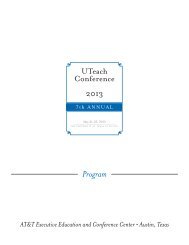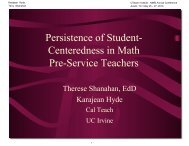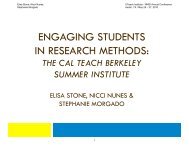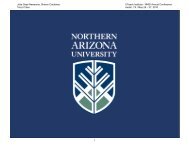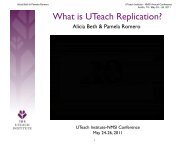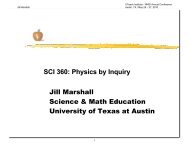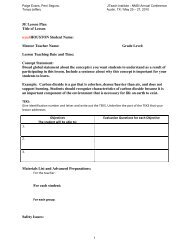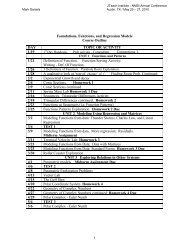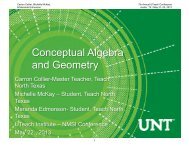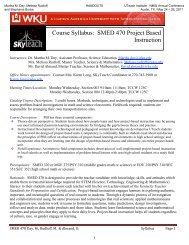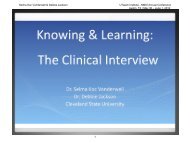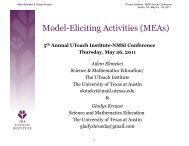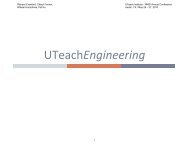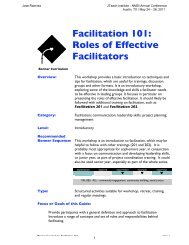Pinhole Camera Design Challenge Instructor Notes. Jill Marshall ...
Pinhole Camera Design Challenge Instructor Notes. Jill Marshall ...
Pinhole Camera Design Challenge Instructor Notes. Jill Marshall ...
Create successful ePaper yourself
Turn your PDF publications into a flip-book with our unique Google optimized e-Paper software.
<strong>Jill</strong> <strong>Marshall</strong> &<br />
Gretchen Edelmon<br />
Handout - 1<br />
<strong>Design</strong> <strong>Challenge</strong> <strong>Instructor</strong> <strong>Notes</strong><br />
UTeach Institute - NMSI Annual Conference<br />
Austin, TX / May 24 – 26, 2011<br />
At the beginning of the main activity day, present the challenge: A physics teacher needs <br />
pinhole cameras for her class to use later that same day. She needs at least four, and has <br />
only cereal boxes, soda can boxes, and oatmeal canisters from which to make them, along <br />
with electrical tape, black construction paper and some tracing paper. A random student <br />
must be able to ‘read’ a target image projected using PowerPoint. <br />
Briefly demonstrate the principles by which the pinhole camera works‐ basically just <br />
showing that light travels in a straight line until it hits something. The light and color unit <br />
from Physics by Inquiry volume I (McDermott & the UW PEG, 1996) is an excellent <br />
resource, but the essence can be conveyed by a diagram or a physical model using yarn or <br />
dowels to represent light rays. <br />
Show examples, including one transmission and one reflection design. <br />
Students have 25 minutes to construct and test their designs. <br />
For the final test randomly selected students read three random letters from a PowerPoint <br />
image using each of the cameras. <br />
Students brainstorm elements necessary for the design process and compare with the <br />
UTeachEngineering model. <br />
For homework, students reflect on the process and develop their own specifications for a <br />
camera to be used in their prospective classrooms. <br />
Supplementary Resources: <br />
Online resources for theory and background are:<br />
http://photo.net/learn/pinhole/pinhole<br />
http://theartofphotography1.blogspot.com/2009/07/camera‐obscura‐pre‐history‐of.html<br />
http://www.pinhole.cz/en/pinholecameras/whatis.html<br />
http://inventors.about.com/od/pstartinventions/a/stilphotography.htm<br />
http://www.pinholeday.org/<br />
These two links are good for opening discussions because they show the camera obscura on a<br />
HUGE scale.<br />
• This article from National Geographic, http://ngm.nationalgeographic.com/2011/05/cameraobscura/oneill‐text<br />
, includes a many examples of full room camera obscura images and a short <br />
video showing how a group of people transformed an office into a camera obscura. <br />
• A giant camera obscura was created as part of the Legacy Photo Project and is described in <br />
the following two links.<br />
http://www.legacyphotoproject.com/ <br />
video: http://video.google.com/videoplay?docid=‐8711483461517692046#<br />
Peer reviewed: <br />
4



